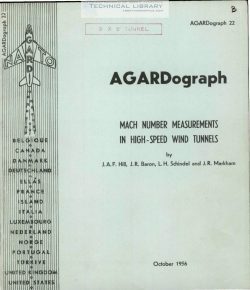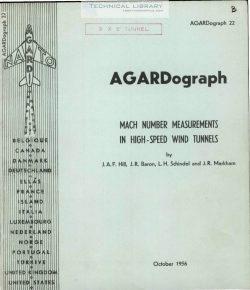AGARD-AG-22

- Version
- 177 Downloads
- 44.14 MB File Size
- 1 File Count
- September 20, 2016 Create Date
- September 20, 2016 Last Updated
Mach Number Measurements in High Speed Wind Tunnels

Measurements of subsonic and supersonic
Mach numbers in air are discussed from
the point of view of calibration measurements
of an empty wind tunnel, of measurements
of local Mach numbers at points in the flow
field around a model, and of simulating free
flight Mach number in the presence of wind
tunnel wall interference. Errors in deducing
Mach number from particular measurements
are discussed and certain measuring
procedures recommended.
Since Mach number is the fundamental
similarity parameter in high-speed flow,’
a discussion of its measurement is worth
some consideration even by experienced re-
searchers. The establishment, at the outset,
of the desired accuracy of Mach number
determination will provide a criterion for
the adequacy of various measuring techniques
and will permit an evaluation of the signifi-
cance of errors.
Many types of tests may be simulated in
a high-speed wind tunnel with results which
are sensitive in various degrees to errors
in Mach number. One standard task certainly
is the measurement of aerodynamic forces
and moments. At a Mach number of 3, a
one percent error in Mach number will result
in about 3.5 percent error in the computation
of force coefficient.
Wind tunnel model construction and force
measuring standards are sufficiently precise
to permit measurements of coefficients to
within 1 percent; hence Mach number must
be known to better than 1/3 percent to maintain
such accuracy. Effects of Mach number
gradient over the region of the model (inves-
tigated by Morris and Winter, Ref.1) also
lead to a required accuracy of 1/3 percent
in Mach number uniformity. It will be
assumed that in order to know the Mach
number to within 1/3 percent, calibration
measurements should be made to 0.1 percent
and errors of this magnitude can not be
disregarded.
In this report, the measurement of
subsonic and supersonic Mach numbers in
air will be discussed from the point of view
of calibration measurements of an empty
wind tunnel, of measurements of local Mach
numbers at points in the flow field around a
model, and of simulating free flight Mach
number in the presence of wind tunnel wall
interference. 'The sensitivity of various
parameters to change in Mach number will
be evaluated and instruments for detecting
the necessary properties described. Errors
in deducing Mach number from particular
measurements will be discussed and certain
measuring procedures recommended.
| File | Action |
|---|---|
| AGARD-AG-22 Mach Number Measurements in High Speed Wind Tunnels.pdf | Download |
Comment On This Post